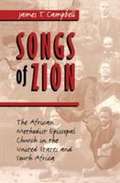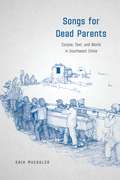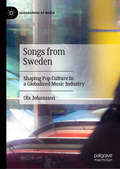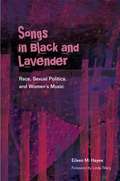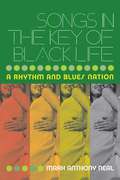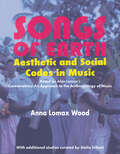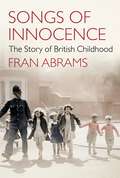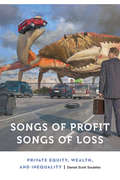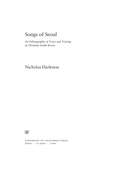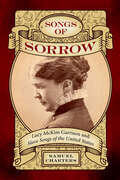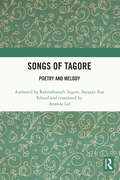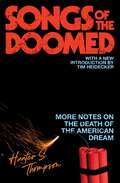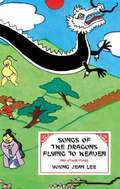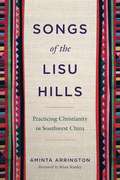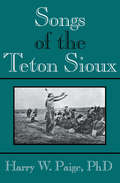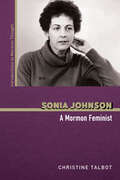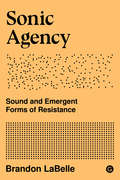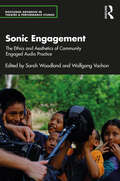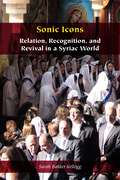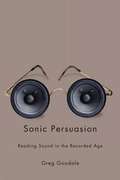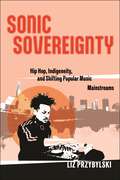- Table View
- List View
Songs Of Zion: The African Methodist Episcopal Church In The United States And South Africa
by James T. CampbellSongs of Zion focuses on the African Methodist Episcopal Church, black America's oldest and largest independent church. Campbell charts the origins and evolution of African American independent churches, arguing that the very act of becoming Christian
Songs for Dead Parents: Corpse, Text, and World in Southwest China
by Erik MuegglerIn a society that has seen epochal change over a few generations, what remains to hold people together and offer them a sense of continuity and meaning? In Songs for Dead Parents, Erik Mueggler shows how in contemporary China death and the practices surrounding it have become central to maintaining a connection with the world of ancestors, ghosts, and spirits that socialism explicitly disavowed. Drawing on more than twenty years of fieldwork in a mountain community in Yunnan Province, Songs for Dead Parents shows how people view the dead as both material and immaterial, as effigies replace corpses, tombstones replace effigies, and texts eventually replace tombstones in a long process of disentangling the dead from the shared world of matter and memory. It is through these processes that people envision the cosmological underpinnings of the world and assess the social relations that make up their community. Thus, state interventions aimed at reforming death practices have been deeply consequential, and Mueggler traces the transformations they have wrought and their lasting effects.
Songs from Sweden: Shaping Pop Culture in a Globalized Music Industry (Geographies of Media)
by Ola JohanssonSongs from Sweden shows how Swedish songwriters and producers are the creative forces behind much of today’s international pop music. As Ola Johansson reveals, the roots of this “music miracle” can be found in Sweden’s culture, economy, and thriving music industry, concentrated in Stockholm. While Swedish writer-producers developed early global recognition for making commercially successful pop music, new Swedish writer-producers have continuously emerged during the last two decades. Global artists travel to Stockholm to negotiate, record, and co-write songs. At the same time, Swedish writer-producers are part of a global collaborative network that spans the world. In addition to concrete commercial accomplishments, the Swedish success is also a result of the acquisition of reputational capital gained through positive associations that the global music industry holds about Swedish music. Ultimately, pop songs from Sweden exhibit a form of cultural hybridity, drawing from both local and global cultural expressions.
Songs from the Loom: A Navajo Girl Learns to Weave
by Susan BraineIn this unique series, Native American authors examine their cultural traditions, from Navajo rug weaving in the Southwest to wild rice gathering in northern Minnesota. Each book describes these customs as they are seen through the eyes of the participants and discusses how Native American people maintain their cultural identities in contemporary society.
Songs in Black and Lavender: Race, Sexual Politics, and Women's Music
by Eileen M. Hayes Linda TilleryDrawing on fieldwork conducted at eight women's music festivals, Eileen M. Hayes shows how studying these festivals--attended by predominately white lesbians--provides critical insight into the role of music and lesbian community formation. She argues that the women's music festival is a significant institutional site for the emergence of black feminist consciousness in the contemporary period. Hayes also offers sage perspectives on black women's involvement in the women's music festival scene, the ramifications of their performances as drag kings in those environments, and the challenges and joys of a black lesbian retreat based on the feminist festival model. With acuity and candor, longtime feminist activist Hayes elucidates why this music scene matters. Veteran vocalist, percussionist, producer, and cultural historian Linda Tillery provides a foreword.
Songs in the Key of Black Life: A Rhythm and Blues Nation
by Mark Anthony NealIn Songs in the Key of Black Life, acclaimed cultural critic Mark Anthony Neal turns his attention to Rhythm and Blues. He argues that R&B-often dismissed as just a bunch of love songs, yet the second most popular genre in terms of sales-can tell us much about the dynamic joys, apprehensions, tensions, and contradictions of contemporary black life, if we listen closely. With a voice as heartfelt and compelling as the best music, Neal guides us through the work of classic and contemporary artists ranging from Marvin Gaye to Macy Gray. In the first section of the book, Rhythm, he uses the music of Meshell N'degeocello, Patti Labelle, Jill Scott, Alicia Keys, and others as guideposts to the major concerns of contemporary black life-issues such as gender, feminist politics, political activism, black masculinity, celebrity, and the fluidity of racial and sexual identity. The second part of the book, Blues, uses the improvisational rhythms of black music as a metaphor to examine currents in black life including the public dispute between Cornel West and Harvard President Lawrence Summers and the firing of BET's talk-show host Tavis Smiley. Songs in the Key of Black Life is a remarkable contribution to the study of black popular music, and valuable reading for anyone interested in how race is lived in America.
Songs of America: Patriotism, Protest, and the Music That Made a Nation
by Jon Meacham Tim McGrawThrough all the years of strife and triumph, America has been shaped not just by our elected leaders and our formal politics but also by our music—by the lyrics, performers, and instrumentals that have helped to carry us through the dark days and to celebrate the bright ones. <P><P>From “The Star-Spangled Banner” to “Born in the U.S.A.,” Jon Meacham and Tim McGraw take readers on a moving and insightful journey through eras in American history and the songs and performers that inspired us. <P><P>Meacham chronicles our history, exploring the stories behind the songs, and Tim McGraw reflects on them as an artist and performer. Their perspectives combine to create a unique view of the role music has played in uniting and shaping a nation. Beginning with the battle hymns of the revolution, and taking us through songs from the defining events of the Civil War, the fight for women’s suffrage, the two world wars, the Great Depression, the civil rights movement, the Vietnam War, and into the twenty-first century, Meacham and McGraw explore the songs that defined generations, and the cultural and political climates that produced them. <P><P>Readers will discover the power of music in the lives of figures such as Harriet Tubman, Franklin Roosevelt, Eleanor Roosevelt, and Martin Luther King, Jr., and will learn more about some of our most beloved musicians and performers, including Marian Anderson, Elvis Presley, Sam Cooke, Aretha Franklin, Bob Dylan, Duke Ellington, Carole King, Bruce Springsteen, and more.Songs of America explores both famous songs and lesser-known ones, expanding our understanding of the scope of American music and lending deeper meaning to the historical context of such songs as “My Country, ’Tis of Thee,” “God Bless America,” “Over There,” “We Shall Overcome,” and “Blowin’ in the Wind.” As Quincy Jones says, Meacham and McGraw have “convened a concert in Songs of America,” one that reminds us of who we are, where we’ve been, and what we, at our best, can be. <P><b>A New York Times Bestseller</b>
Songs of Earth: Aesthetic and Social Codes in Music
by Anna L. WoodBased upon Cantometrics: An Approach to the Anthropology of Music (1976), by Alan Lomax, Songs of Earth: Aesthetic and Social Codes in Music is a contemporary guide to understanding and exploring Cantometrics, the system developed by Lomax and Victor Grauer for analyzing the formal elements of music related to human geography and sociocultural patterning. This carefully constructed cross-cultural study of world music revealed deep-rooted performance patterns and aesthetic preferences and their links with environmental factors and ancient socioeconomic practices. This new and updated edition is for anyone wishing to understand and more deeply appreciate the forms and sociocultural contexts of the musics of the world’s peoples, and it is designed to be used by both scholars and laypeople.Part One of the book consists of a practical guide to using the Cantometrics system, a course with musical examples to test one’s understanding of the material, a theoretical framework to put the methodology in context, and an illustration of the method used to explore the roots of popular music. Part Two includes guides to four other analytical systems that Lomax developed, which focus on orchestration, phrasing and breath management, vowel articulation, instrumentation, and American popular music. Part Three provides resources for educators who wish to use the Cantometrics system in their classrooms, a summary of the findings and hypotheses of Lomax’s original research, and a discussion of Cantometrics’ criticisms, applications, and new approaches, and it includes excerpts of Lomax’s original writings about world song style and cultural equity.
Songs of Innocence: The Story of British Childhood
by Fran AbramsAs recently as 100 years ago British children existed in ways now unthinkable; boys as young as eight worked grueling hours in unlit factories; girls were sold into sexual slavery with dolls still in their grasp; and boys at schools like Rugby and Harrow were brutally trained for their future at the helm of Britain's vast red empire. This book charts the transformation of childhood in the UK from early Victorian disagreements about childrearing to the Scouts' very direct involvement in World War I. Poignant first-hand accounts of poverty and deprivation as well as innocent pleasures carry the reader through a Dickensian landscape of urchins and Fauntleroys, the cosseted lives of Edwardian children to the self-sufficient charges of Baden-Powell. Fran Abrams draws distinctions along class lines and divisions such as town and country, Romantic and conservative, to achieve a historical perspective shows the progression of the idea of childhood through a century of massive social change brought about by urbanization, war, and medico-psychological advances. Songs of Innocence employs searing personal testimony and immaculate research to provide a fascinating exposition of the past and a mirror for the present.
Songs of Profit, Songs of Loss: Private Equity, Wealth, and Inequality (Anthropology of Contemporary North America)
by Daniel Scott SoulelesSince the early 1980s, private equity investors have heralded and shepherded massive changes in American capitalism. From outsourcing to excessive debt taking, private equity investment helped normalize once-taboo business strategies while growing into an over $3 trillion industry in control of thousands of companies and millions of workers. Daniel Scott Souleles opens a window into the rarefied world of private equity investing through ethnographic fieldwork on private equity financiers. Songs of Profit, Songs of Loss documents how and why investors buy, manage, and sell the companies that they do; presents the ins and outs of private equity deals, management, and valuation; and explains the historical context that gave rise to private equity and other forms of investor-led capitalism. In addition to providing invaluable ethnographic insight, Songs of Profit, Songs of Loss is also an anthropological study of inequality as Souleles connects the core components of financial capitalism to economic disparities. Souleles uses local ideas of “value” and “time” to frame the ways private equity investors comprehend their work and to show how they justify the prosperity and poverty they create. Throughout, Souleles argues that understanding private equity investors as contrasted with others in society writ large is essential to fully understanding private equity within the larger context of capitalism in the United States.
Songs of Seoul
by Nicholas HarknessSongs of Seoul is an ethnographic study of voice in South Korea, where the performance of Western opera, art songs, and choral music is an overwhelmingly Evangelical Christian enterprise. Drawing on fieldwork in churches, concert halls, and schools of music, Harkness argues that the European-style classical voice has become a specifically Christian emblem of South Korean prosperity. By cultivating certain qualities of voice and suppressing others, Korean Christians strive to personally embody the social transformations promised by their religion: from superstition to enlightenment; from dictatorship to democracy; from sickness to health; from poverty to wealth; from dirtiness to cleanliness; from sadness to joy; from suffering to grace. Tackling the problematic of voice in anthropology and across a number of disciplines, Songs of Seoul develops an innovative semiotic approach to connecting the materiality of body and sound, the social life of speech and song, and the cultural voicing of perspective and personhood.
Songs of Slavery and Emancipation (Margaret Walker Alexander Series in African American Studies)
by Mat CallahanThroughout the history of slavery, enslaved people organized resistance, escape, and rebellion. Sustaining them in this struggle was their music, some examples of which are sung to this day. While the existence of slave songs, especially spirituals, is well known, their character is often misunderstood. Slave songs were not only lamentations of suffering or distractions from a life of misery. Some songs openly called for liberty and revolution, celebrating such heroes as Gabriel Prosser and Nat Turner, and, especially, celebrating the Haitian Revolution.The fight for freedom also included fugitive slaves, free Black people, and their white allies who brought forth a set of songs that were once widely disseminated but are now largely forgotten, the songs of the abolitionists. Often composed by fugitive slaves and free Black people, and first appearing in the eighteenth century, these songs continued to be written and sung until the Civil War. As the movement expanded, abolitionists even published song books used at public meetings. Mat Callahan presents recently discovered songs composed by enslaved people explicitly calling for resistance to slavery, some originating as early as 1784 and others as late as the Civil War. He also presents long-lost songs of the abolitionist movement, some written by fugitive slaves and free Black people, challenging common misconceptions of abolitionism. Songs of Slavery and Emancipation features the lyrics of fifteen slave songs and fifteen abolitionist songs, placing them in proper historical context and making them available again to the general public. These songs not only express outrage at slavery but call for militant resistance and destruction of the slave system. There can be no doubt as to their purpose: the abolition of slavery, the emancipation of African American people, and a clear and undeniable demand for equality and justice for all humanity.
Songs of Sorrow: Lucy McKim Garrison and Slave Songs of the United States (American Made Music Series)
by Samuel ChartersIn the spring of 1862, Lucy McKim, the nineteen-year-old daughter of a Philadelphia abolitionist Quaker family, traveled with her father to the Sea Islands of South Carolina to aid him in his efforts to organize humanitarian aid for thousands of newly freed slaves. During her stay she heard the singing of the slaves in their churches, as they rowed their boats from island to island, and as they worked and played. Already a skilled musician, she determined to preserve as much of the music as she could, quickly writing down words and melodies, some of them only fleeting improvisations. Upon her return to Philadelphia, she began composing musical settings for the songs and in the fall of 1862 published the first serious musical arrangements of slave songs. She also wrote about the musical characteristics of slave songs, and published, in a leading musical journal of the time, the first article to discuss what she had witnessed. In Songs of Sorrow: Lucy McKim Garrison and “Slave Songs of the United States,” renowned music scholar Samuel Charters tells McKim's personal story. Letters reveal the story of young women's lives during the harsh years of the war. At the same time that her arrangements of the songs were being published, a man with whom she had an unofficial “attachment” was killed in battle, and the war forced her to temporarily abandon her work. In 1865 she married Wendell Phillips Garrison, son of abolitionist William Lloyd Garrison, and in the early months of their marriage she proposed that they turn to the collection of slave songs that had long been her dream. She and her husband—a founder and literary editor of the recently launched journal The Nation—enlisted the help of two associates who had also collected songs in the Sea Islands. Their book, Slave Songs of the United States, appeared in 1867. After a long illness, ultimately ending in paralysis, she died at the age of thirty-four in 1877. This book reclaims the story of a pioneer in ethnomusicology, one whose influential work affected the Fisk Jubilee Singers and many others.
Songs of Tagore: Poetry and Melody
by Rabindranath Tagore Satyajit RayRabindranath Tagore composed over 2000 songs that are revered and sung by Bengalis everywhere. However, they remain mostly unknown to listeners from other communities. This book brings the Nobel Laureate’s unique music — Rabindrasangit — to a global audience, with a lucid introduction by Ananda Lal as well as selected songs in international transcription and English translation. It includes an essay written originally in Bengali by the celebrated filmmaker Satyajit Ray, himself a Tagore student and music composer. Ray presents his thoughts on Rabindrasangit, its nuances, music, history, and usage. Lal has also translated this essay into English for the first time. The book also presents for the first time faithful staff notations of all 41 songs in three of Tagore’s major plays — Rakta-karavi, Tapati, and Arup Ratan — providing a thematic unity to the music section. This volume will be of interest to Tagore and Ray enthusiasts and specialists, musicologists, and students of music, theatre, literature, performance studies, and cultural studies. It will appeal not only to scholars but to general readers wanting to know more about Tagore’s songs, as well as directors, arrangers, composers, and singers who may wish to perform or interpret the songs transcribed.
Songs of the Doomed: More Notes on the Death of the American Dream
by Hunter S. ThompsonFirst published in 1990, Songs of the Doomed is back in print -- by popular demand! In this third and most extraordinary volume of the Gonzo Papers, Dr. Hunter S. Thompson recalls high and hideous moments in his thirty years in the Passing Lane -- and no one is safe from his hilarious, remarkably astute social commentary. With Thompson's trademark insight and passion about the state of American politics and culture, Songs of the Doomed charts the long, strange trip from Kennedy to Quayle in Thompson's freewheeling, inimitable style. Spanning four decades -- 1950 to 1990 -- Thompson is at the top of his form while fleeing New York for Puerto Rico, riding with the Hell's Angels, investigating Las Vegas sleaze, grappling with the "Dukakis problem," and finally, detailing his infamous lifestyle bust, trial documents, and Fourth Amendment battle with the Law. These tales -- often sleazy, brutal, and crude -- are only the tip of what Jack Nicholson called "the most baffling human iceberg of our time."Songs of the Doomed is vintage Thompson -- a brilliant, brazen, bawdy compilation of the greatest sound bites of Gonzo journalism from the past thirty years.
Songs of the Dragons Flying to Heaven and Other Plays
by Young Jean Lee"Bold, unguarded work . . . that resists pat definition. [Young Jean] Lee has penned profane lampoons of motivational bromides (Pullman, WA) and the Romantic poets (The Appeal). Now she piles her deconstructive scorn upon ethnic stereotypes in Songs of the Dragons Flying to Heaven, a sweet-and-sour parade of Asian minstrelsy."--Time Out New York"A perverse, provocative, and very funny festival of racism . . . Songs offers not only chauvinistic monologues and ass-slapping Korean dances, but also a rigorous exploration of art-making and its associated terrors."--The Village Voice"Have you ever noticed how most Asian Americans are slightly brain-damaged from having grown up with Asian parents?" begins the Korean American protagonist of Songs of the Dragons Flying to Heaven, the singular work of Young Jean Lee, whose plays are like nothing you have ever seen or read. This is the first collection by the downtown writer-director, whose explorations of stereotypes of race, gender, and religion are unflinching--and seat-squirming funny. Also includes Groundwork of the Metaphysic of Morals; The Appeal; Pullman, WA; Church; and Yaggoo.Young Jean Lee was born in Korea and moved to the United States at age two. She grew up in Pullman, Washington, and attended college at the University of California, Berkeley, where she also studied Shakespeare in the English PhD program before moving to New York. She is the founder of the Young Jean Lee's Theater Company, where she directs her own work, and has toured internationally in Vienna, Hanover, Berlin, Switzerland, Brussels, Norway, France, and Rotterdam; and across the United States in Portland, Seattle, Pittsburgh, and Minneapolis. She is the recipient of a 2007 Emerging Playwright OBIE Award.
Songs of the Lisu Hills: Practicing Christianity in Southwest China (World Christianity #2)
by Aminta ArringtonThe story of how the Lisu of southwest China were evangelized one hundred years ago by the China Inland Mission is a familiar one in mission circles. The subsequent history of the Lisu church, however, is much less well known. Songs of the Lisu Hills brings this history up to date, recounting the unlikely story of how the Lisu maintained their faith through twenty-two years of government persecution and illuminating how Lisu Christians transformed the text-based religion brought by the missionaries into a faith centered around an embodied set of Christian practices.Based on ethnographic fieldwork as well as archival research, this volume documents the development of Lisu Christianity, both through larger social forces and through the stories of individual believers. It explores how the Lisu, most of whom remain subsistence farmers, have oriented their faith less around cognitive notions of belief and more around participation in a rhythm of shared Christian practices, such as line dancing, attending church and festivals, evangelizing, working in each other’s fields, and singing translated Western hymns. These embodied practices demonstrate how Christianity developed in the mountainous margins of the world’s largest atheist state.A much-needed expansion of the Lisu story into a complex study of the evolution of a world Christian community, this book will appeal to scholars working at the intersections of World Christianity, anthropology of religion, ethnography, Chinese Christianity, and mission studies.
Songs of the Lisu Hills: Practicing Christianity in Southwest China (World Christianity #2)
by Aminta ArringtonThe story of how the Lisu of southwest China were evangelized one hundred years ago by the China Inland Mission is a familiar one in mission circles. The subsequent history of the Lisu church, however, is much less well known. Songs of the Lisu Hills brings this history up to date, recounting the unlikely story of how the Lisu maintained their faith through twenty-two years of government persecution and illuminating how Lisu Christians transformed the text-based religion brought by the missionaries into a faith centered around an embodied set of Christian practices.Based on ethnographic fieldwork as well as archival research, this volume documents the development of Lisu Christianity, both through larger social forces and through the stories of individual believers. It explores how the Lisu, most of whom remain subsistence farmers, have oriented their faith less around cognitive notions of belief and more around participation in a rhythm of shared Christian practices, such as line dancing, attending church and festivals, evangelizing, working in one another’s fields, and singing translated Western hymns. These embodied practices demonstrate how Christianity developed in the mountainous margins of the world’s largest atheist state.A much-needed expansion of the Lisu story into a complex study of the evolution of a world Christian community, this book will appeal to scholars working at the intersections of World Christianity, anthropology of religion, ethnography, Chinese Christianity, and mission studies.
Songs of the Teton Sioux
by Harry W. PaigeThe beautiful and mysterious song of the Sioux is a carefully crafted and highly individualized ritual performed to invoke the strength of the spirits in order to harness the power of nature. In this, the first literary study of a fascinating tradition, Dr. Harry W. Paige immerses himself in the Sioux society and culture to unlock the mystery of this enchanting ritual. Passionate and intoxicating, Songs of the Teton Sioux will astound and fascinate scholar and casual reader alike. The voice of their people may be fading, but the powerful songs of the Sioux will live on forever.
Sonia Johnson: A Mormon Feminist (Introductions to Mormon Thought)
by Christine TalbotFew figures in the history of the Church of Jesus Christ of Latter-day Saints provoke such visceral responses as Sonia Johnson. Her unrelenting public support of the Equal Rights Amendment (ERA) made her the face of LDS feminism while her subsequent excommunication roiled the faith community. Christine Talbot tells the story of Sonia’s historic confrontation with the Church within the context of the faith’s first large-scale engagement with the feminist movement. A typical if well-educated Latter-day Saints homemaker, Sonia was moved to action by the all-male LDS leadership’s opposition to the ERA and a belief the Church should stay out of politics. Talbot uses the activist’s experiences and criticisms to explore the ways Sonia’s ideas and situation sparked critical questions about LDS thought, culture, and belief. She also illuminates how Sonia’s excommunication shaped LDS feminism, the Church’s antagonism to feminist critiques, and the Church itself in the years to come. A revealing and long-overdue account, Sonia Johnson explores the life, work, and impact of the LDS feminist.
Sonic Agency: Sound and Emergent Forms of Resistance (Goldsmiths Press / Sonics Series #1)
by Brandon LabelleA timely exploration of whether sound and listening can be the basis of political change.In a world dominated by the visual, could contemporary resistances be auditory? This timely and important book from Goldsmiths Press highlights sound's invisible, disruptive, and affective qualities and asks whether the unseen nature of sound can support a political transformation. In Sonic Agency, Brandon LaBelle sets out to engage contemporary social and political crises by way of sonic thought and imagination. He divides sound's functions into four figures of resistance—the invisible, the overheard, the itinerant, and the weak—and argues for their role in creating alternative “unlikely publics” in which to foster mutuality and dissent. He highlights existing sonic cultures and social initiatives that utilize or deploy sound and listening to address conflict, and points to their work as models for a wider movement. He considers issues of disappearance and hidden culture, nonviolence and noise, creole poetics, and networked life, aiming to unsettle traditional notions of the “space of appearance” as the condition for political action and survival.By examining the experience of listening and being heard, LaBelle illuminates a path from the fringes toward hope, citizenship, and vibrancy. In a current climate that has left many feeling they have lost their voices, it may be sound itself that restores it to them.
Sonic Engagement: The Ethics and Aesthetics of Community Engaged Audio Practice (Routledge Advances in Theatre & Performance Studies)
by Sarah Woodland Wolfgang VachonSonic Engagement examines the relationship between community engaged participatory arts and the cultural turn towards audio, sound, and listening that has been referred to as the 'sonic turn'. This edited collection investigates the use of sound and audio production in community engaged participatory arts practice and research. The popularity of podcast and audio drama, combined with the accessibility and portability of affordable field recording and home studio equipment, makes audio a compelling mode of participatory creative practice. This book maps existing projects occurring globally through a series of case study chapters that exemplify community engaged creative audio practice. The studies focus on audio and sound-based arts practices that are undertaken by artists and arts-led researchers in collaboration with (and from within) communities and groups. These practices include—applied audio drama, community engaged podcasting, sound and verbatim theatre, participatory sound art, community-led acoustic ecology, sound and media walks, digital storytelling, oral history and reminiscence, and radio drama in health and community development. The contributors interrogate the practical, political, and aesthetic potentialities of using sound and audio in community engaged arts practice, as well as its tensions and possibilities as an arts-led participatory research methodology. This book provides the first extensive analysis of what sound and audio brings to participatory, interdisciplinary, arts-led approaches, representing a vital resource for community arts, performance practice, and research in the digital age.
Sonic Icons: Relation, Recognition, and Revival in a Syriac World (Orthodox Christianity and Contemporary Thought)
by Sarah Bakker KelloggA vivid, artfully crafted, and deeply hopeful account of one community’s struggle to rediscover and reinvent itself after a century of genocidal loss, dispossession, and displacementTo the extent that Middle Eastern Christians register in Euro-American political imaginaries, they are usually invoked to justify Western military intervention into countries like Iraq or Syria, or as an exemption to anti-Islamic immigration policies because of an assumption that their Christianity makes them easily assimilable in the so-called “Judeo-Christian” West.Using the tools of multisensory ethnography, Sonic Icons uncovers how these views work against the very communities they are meant to benefit. Through long term fieldwork in the Netherlands among Syriac Orthodox Christians—also known as Assyrians, Aramaeans, and Syriacs—Bakker Kellogg reveals how they intertwine religious practice with political activism to save Syriac Christianity from the twin threats of political violence in the Middle East and cultural assimilation in Europe.In a historical moment when much of their tradition has been forgotten or destroyed, their story of self-discovery is one of survival and reinvention. By reviving the late antique Syriac liturgical tradition known as the Daughters and Sons of the Covenant, they seek a complex form of recognition for what they understand to be the ethical core of Christian kinship in an ethnic as well as in a religious sense, despite living in societies that do not recognize this unhyphenated form of ethnoreligiosity as a politically legitimate mode of public identity. Drawing on both theological and linguistic understandings of the icon, Sonic Icons rethinks foundational theoretical accounts of ethnicization, racialization, and secularization by examining how kinship gets made, claimed, and named in the global politics of minority recognition. The icon, as a site of communicative and reproductive power, illuminates how these processes are shaped by religious histories of struggle for sovereignty over the reproductive future.
Sonic Persuasion: Reading Sound in the Recorded Age
by Greg GoodaleSonic Persuasion: Reading Sound in the Recorded Age critically analyzes a range of sounds on vocal and musical recordings, on the radio, in film, and in cartoons to show how sounds are used to persuade in subtle ways. Greg Goodale explains how and to what effect sounds can be "read" like an aural text, demonstrating this method by examining important audio cues such as dialect, pausing, and accent in presidential recordings at the turn of the twentieth century. Goodale also shows how clocks, locomotives, and machinery are utilized in film and literature to represent frustration and anxiety about modernity, and how race and other forms of identity came to be represented by sound during the interwar period. In highlighting common sounds of industry and war in popular media, Sonic Persuasion also demonstrates how programming producers and governmental agencies employed sound to evoke a sense of fear in listeners. Goodale provides important links to other senses, especially the visual, to give fuller meaning to interpretations of identity, culture, and history in sound.
Sonic Sovereignty: Hip Hop, Indigeneity, and Shifting Popular Music Mainstreams (Postmillennial Pop)
by Liz PrzybylskiHonorable Mention, 2024 Alan Merriam Prize, given by the Society for EthnomusicologyWhat does sovereignty sound like?Sonic Sovereignty considers how contemporary Indigenous musicians champion self-determination through musical expression in Canada and the United States. The framework of “sonic sovereignty” connects self-definition, collective determination, and Indigenous land rematriation to the immediate and long-lasting effects of expressive culture. Liz Przybylski covers online and offline media spaces, following musicians and producers as they, and their music, circulate across broadcast and online networks. Przybylski documents and reflects on shifts in both the music industry and political landscape over the course of a decade: as the ways in which people listen to, consume, and interact with popular music have radically changed, extensive public conversations have flourished around contemporary Indigenous culture, settler responsibility, Indigenous leadership, and decolonial futures.Sonic Sovereignty encourages us to experiment with temporal possibilities of listening by detailing moments when a sample, lyric, or musical reference moves a listener out of normative time. Nonlinear storytelling practices from hip hop music and other North American Indigenous sonic practices inform these generative listenings. The musical readings presented in this book thus explore how musicians use tools to help listeners embrace rupture, and how out-of-time listening creates decolonial possibilities.
